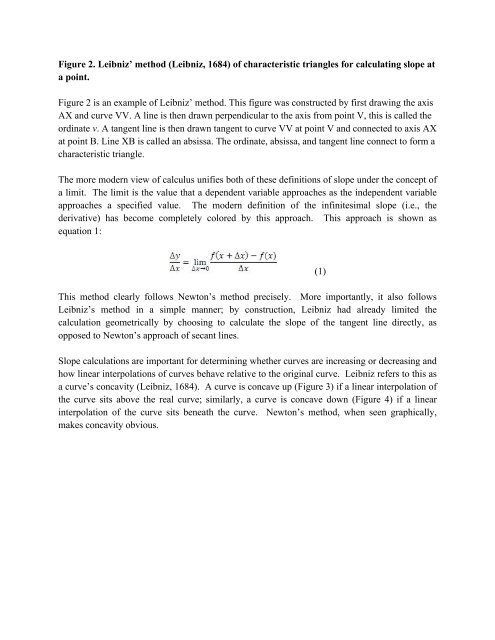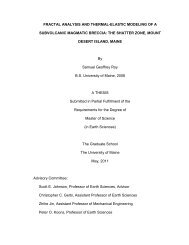Exploring the Methods of Differential Calculus through the ...
Exploring the Methods of Differential Calculus through the ...
Exploring the Methods of Differential Calculus through the ...
Create successful ePaper yourself
Turn your PDF publications into a flip-book with our unique Google optimized e-Paper software.
Figure 2. Leibniz’ method (Leibniz, 1684) <strong>of</strong> characteristic triangles for calculating slope at<br />
a point.<br />
Figure 2 is an example <strong>of</strong> Leibniz’ method. This figure was constructed by first drawing <strong>the</strong> axis<br />
AX and curve VV. A line is <strong>the</strong>n drawn perpendicular to <strong>the</strong> axis from point V, this is called <strong>the</strong><br />
ordinate v. A tangent line is <strong>the</strong>n drawn tangent to curve VV at point V and connected to axis AX<br />
at point B. Line XB is called an absissa. The ordinate, absissa, and tangent line connect to form a<br />
characteristic triangle.<br />
The more modern view <strong>of</strong> calculus unifies both <strong>of</strong> <strong>the</strong>se definitions <strong>of</strong> slope under <strong>the</strong> concept <strong>of</strong><br />
a limit. The limit is <strong>the</strong> value that a dependent variable approaches as <strong>the</strong> independent variable<br />
approaches a specified value. The modern definition <strong>of</strong> <strong>the</strong> infinitesimal slope (i.e., <strong>the</strong><br />
derivative) has become completely colored by this approach. This approach is shown as<br />
equation 1:<br />
This method clearly follows Newton’s method precisely. More importantly, it also follows<br />
Leibniz’s method in a simple manner; by construction, Leibniz had already limited <strong>the</strong><br />
calculation geometrically by choosing to calculate <strong>the</strong> slope <strong>of</strong> <strong>the</strong> tangent line directly, as<br />
opposed to Newton’s approach <strong>of</strong> secant lines.<br />
Slope calculations are important for determining whe<strong>the</strong>r curves are increasing or decreasing and<br />
how linear interpolations <strong>of</strong> curves behave relative to <strong>the</strong> original curve. Leibniz refers to this as<br />
a curve’s concavity (Leibniz, 1684). A curve is concave up (Figure 3) if a linear interpolation <strong>of</strong><br />
<strong>the</strong> curve sits above <strong>the</strong> real curve; similarly, a curve is concave down (Figure 4) if a linear<br />
interpolation <strong>of</strong> <strong>the</strong> curve sits beneath <strong>the</strong> curve. Newton’s method, when seen graphically,<br />
makes concavity obvious.<br />
(1)
















